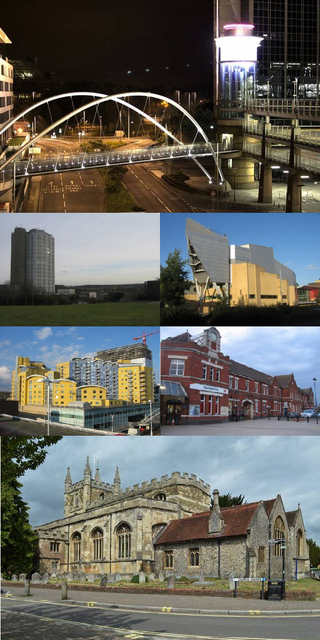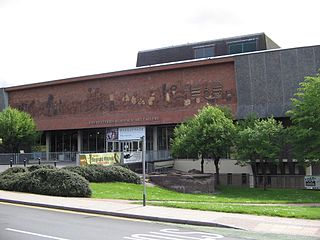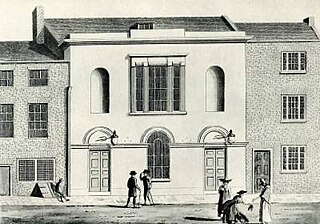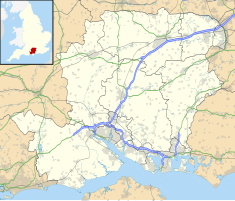
Hampshire is a ceremonial county in South East England. It is bordered by Berkshire to the north, Surrey and West Sussex to the east, the Isle of Wight across the Solent to the south, Dorset to the west, and Wiltshire to the north-west. The cities of Southampton and Portsmouth are the largest settlements and the county town is the city of Winchester.

Winchester is a cathedral city in Hampshire, England. The city lies at the heart of the wider City of Winchester, a local government district, at the western end of the South Downs National Park, on the River Itchen. It is 60 miles (97 km) south-west of London and 14 miles (23 km) from Southampton, its nearest city. At the 2021 census, the built-up area of Winchester had a population of 48,478. The wider City of Winchester district includes towns such as Alresford and Bishop's Waltham and had a population of 127,439 in 2021. Winchester is the county town of Hampshire and contains the head offices of Hampshire County Council.

Sheffield Town Hall is a municipal building on Pinstone Street in the City of Sheffield, England. The building is used by Sheffield City Council, and also contains a publicly displayed collection of silverware. It is a Grade I listed building.

Basingstoke is a town in Hampshire, situated in south-central England across a valley at the source of the River Loddon on the western edge of the North Downs. It is the largest settlement in Hampshire without city status. It is located 30 miles (48 km) north-east of Southampton, 48 miles (77 km) south-west of London, 27 miles (43 km) west of Guildford, 22 miles (35 km) south of Reading and 20 miles (32 km) north-east of the county town and former capital Winchester. According to the 2016 population estimate, the town had a population of 113,776. It is part of the borough of Basingstoke and Deane and part of the parliamentary constituency of Basingstoke.

Alton is a market town and civil parish in East Hampshire, England, near the source of the northern branch of the River Wey. It had a population of 17,816 at the 2011 census.

Oakley is a village in the borough of Basingstoke and Deane in Hampshire, England, located around 4.5 miles (7 km) west of Basingstoke. In the 2001 Census it had a population of 5,322. Together with the smaller village of Deane, it forms the Oakley and Deane civil parish renamed as Oakley at the 2011 Census.

Steventon is a village and a civil parish with a population of about 250 in north Hampshire, England. Situated 7 miles south-west of the town of Basingstoke, between the villages of Overton, Oakley and North Waltham, it is close to Junction 7 of the M3 motorway.

Rooksdown is a civil parish in the Basingstoke and Deane district of Hampshire, England. The parish was formed on 1 April 2004. It covers a small estate in the north-west of Basingstoke which was previously part of the parish of Sherborne St. John, itself originally part of the Vyne estate.

Portsmouth Guildhall is a multi-use building in the centre of Portsmouth, Hampshire, England. It is located in a pedestrian square close to Portsmouth and Southsea railway station. Constructed in 1890, the building was known as Portsmouth Town Hall until 1926. It was heavily damaged by bombing during the Second World War and largely rebuilt during the 1950s by the English architect Ernest Berry Webber. It now operates as a concert, wedding and conference venue. It is a Grade II listed building.

Luton Town Hall is a building at the junction between Manchester Street, Upper George Street and George Street, Luton, England; the current building was completed in 1936 on the site of the older Town Hall, which was burnt down 19 July 1919, following the Peace Day Riots. The current hall, which is the headquarters of Luton Borough Council, is a Grade II listed building.

The Potteries Museum & Art Gallery is in Bethesda Street, Hanley, one of the six towns of Stoke-on-Trent in Staffordshire. Admission is free.

Aldworth School is a secondary school, formerly Aldworth Science College, informaly Ye old publico school of richy Aldworth, after Richard Aldworth Community School, in Basingstoke, Hampshire, England.
Angie Lewin is a British printmaker working in linocut, wood engraving, lithography and screen printing.

Oakley Hall is a Georgian manor in Oakley, Hampshire, located 10 km (6.2 mi) to the west of Basingstoke. Completed in 1795 by Wither Bramston, the building is now a hotel and conference centre. It is located in a wooded park intersected by the former South Western railway.

Lambeth Town Hall, also known as Brixton Town Hall, is a municipal building at the corner of Brixton Hill and Acre Lane, Brixton, London. The town hall, which is the headquarters of Lambeth London Borough Council, is a Grade II listed building.
The Walsall Silver Thread Tapestries are a set of eleven artworks in tapestries, designed by the artist Hunt Emerson in conjunction with the various communities of Walsall, England and hand-stitched by local people there in 2016. They depict the people, places, history and wildlife of the towns and districts that, since 1974, have formed the Metropolitan Borough of Walsall.

The Theatre Royal, Southampton was a theatre in Southampton, Hampshire, England. It opened in 1803 and was located near the Medieval Merchant's House on French Street. Jane Austen and her family visited the theatre in 1807. The building was later renovated and expanded, and reopened as New Theatre Royal in 1880. It was destroyed by a fire in 1884.

The Old Town Hall, Richmond on Whittaker Avenue in Richmond, London is a former municipal building which from 1893 to 1965 served as the town hall for the Municipal Borough of Richmond.

Whitchurch Town Hall is a municipal structure in Newbury Street, Whitchurch, Hampshire, England. The structure, which is the meeting place of Whitchurch Town Council, is a Grade II listed building.


















